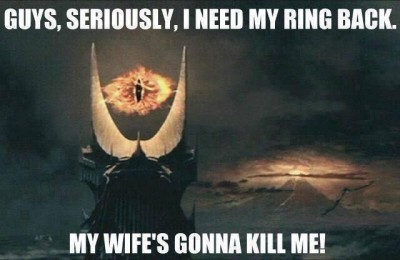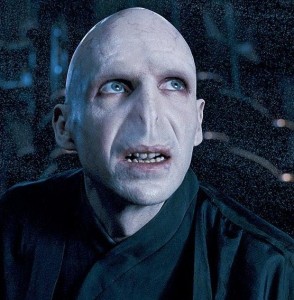Just before the holidays, I turned on the Fellowship of the Ring movie in a fit of nostalgia and passively watched as I cleaned the apartment. And somewhere between vacuuming at Rivendell and swiffering at Lothlorien, I realized something I’d never realized before: Sauron is a terrible villain.
I mean, once you get past the admittedly terrifying lidless-eye Panopticon thing, Sauron is pretty simplistic as a villain. He’s evil–that’s about it. Why did he secretly forge the One Ring in the first place? To rule all the other Rings of Power. Why would he want to rule the elves, the dwarves, and mankind? Duh–evil! Why did he send his Host against the army of the Alliance on the plains of Dagorlad? Evil! Why is he obsessed with getting the One Ring back from Frodo and taking over Middle-earth? Evil, evil, evil!
As a writer, you hear a lot of the same advice over and over again. And when it comes to villains and antagonistic forces, the advice is always the same: one-dimensional villains just don’t cut it. Your villain must be more than just evil–he or she must be as well-rounded and complex as your other characters. The villain must have a backstory that explains his actions and lends his motivations depth and flavor. Furthermore, the villain’s actions must arise from a place of logic; even if it is a flawed, unsound logic, his actions must be comprehensible, if not sympathetic, to the reader. The villain’s role is to challenge the hero to reach great heights. He must act as both a catalyst for heroism and a foil for the hero’s own complex motivations.
Let’s look at another widely-known villain for a moment: He-Who-Shall-Not-Be-Named a.k.a Voldemort. Throughout the seven volumes of the Harry Potter saga, Voldemort is transformed from a faceless shadow (physically and metaphorically) into a complex antagonist with a intricately drawn backstory and complex motivations. Rowling makes a point of making Voldemort real. Yes, we still hate Voldemort. Yes, Voldemort is still evil. But we as readers at least have an idea of why. We know what factors surrounding his birth, childhood, adolescence and adulthood shaped him into the paragon of evil Harry faces at the end of book seven.
Now, I haven’t read The Silmarillion or any of the other volumes that together make up the Middle-earth mythology. My reading of Tolkien has been confined to The Hobbit and The Lord of the Rings trilogy. So it’s entirely possible that Sauron has a complex background to explain his raging evil-ness that I just don’t know about. But if you ask me, Sauron’s a bit one-dimensional to really qualify as a true antagonist.
So who’s the real villain in The Lord of the Rings? How about Saruman the White, who betrayed his wizard order for dark power? How about the One Ring, an inanimate object with a mind of its own? How about the greed of humanity? Or–let’s be honest–the gross incompetence of the fellowship, most notably Gandalf?
Just saying.
Do you think Sauron is a good villain? Do you have any favorite sympathetic villains? Leave your thoughts in the comment section below!


I agree and disagree. Sauron is a terrible villain if we’re to invest in him and care about his motivations and background…but we’re not. Like you, my exploration into deeper Middle Earth history is limited, but apparently that stuff is available. I tend to think that Sauron is much more like a MacGuffin than a traditional villain…his role is basically to introduce conflict. The characters never actually meet him, he’s wicked and powerful beyond the abilities of any character, etc. He’s simply there to provide an almost insurmountable challenge to engage the Fellowship. He’s an ancient and unspeakable evil that offers no compromise. He does this well.
Saruman is a much more “likable” antagonist. We see his motivations, his interests, etc. We’re meant to almost sympathize with him and understand that good can turn bad and bad can turn good in Middle Earth.. Sauron isn’t like that. Voldemort is another good example of an antagonist with which we’re supposed to develop some rapport–we’re not to like him but we see his journey from a troubled child to evil overlord. At that’s the point–we see how Harry had very similar upbringing (lack of parents, surprised to be a wizard) but chose a very different path. It makes Harry’s final showdown with him all the more meaningful. And he does that well.
Guess who we, as mere mortals that can choose good or evil (and aren’t incredibly powerful) relate to more? P.S. If you’re interested in a study on villains, read “I Wear the Black Hat” by Chuck Klosterman–hilarious and insightful. Loved the post!
Ben